Asus ROG Strix Scar II Gaming Laptop, 17.3” 144Hz IPS-Type FHD, NVIDIA GeForce RTX 2070 8GB
Asus ROG Strix Scar II Gaming Laptop, 17.3” 144Hz IPS-Type FHD, NVIDIA GeForce RTX 2070 8GB
Asus ROG Strix Scar II Gaming Laptop, 17.3” 144Hz IPS-Type FHD, NVIDIA GeForce RTX 2070 8GB, Intel Core i7-8750H Processor, 16GB DDR4 RAM, 512GB PCIe SSD + 1TB SSHD, RGB KB, Windows 10 - GL704GW-DS76Description for ASUS ROG Strix GL704GW Scar II Gaming Laptop - 17.3” 144Hz IPS-Type FHD, Intel Core i7-8750H, 16GB RAM, 1TB HDD + 256GB SSD, NVIDIA GeForce RTX 2070 8GB, RGB KB, Windows 10 | GL704GW-EV011T
New ROG Strix SCAR II Gaming Laptop
Bringing you even more power and style for FPS and Battle Royale gaming with the latest NVIDIA GeForce RTX graphics. Boasting a 144Hz refresh rate display with ultra-narrow bezel, PCIe NVMe SSD, and an 8th Gen Intel Core i7 processor, the new STRIX GL504 has all the power needed to conquer the latest titles without breaking a sweat.
ROG Strix SCAR II GL504
ROG Strix GL504 sharpens your PC gaming experience thanks to a 144Hz narrow-bezel display with an ultrafast 3ms gray-to-gray (GTG) response time. Paired with GeForce RTX 20-series graphics, SCAR II offers amazing energy efficiency, innovative new gaming technologies, and breakthrough VR immersion.


GeForce RTX Graphics
NVIDIA® GeForce RTX™ delivers the ultimate PC gaming experience. RTX graphics cards bring together real-time ray tracing, artificial intelligence, and programmable shading. This is a whole new way to experience games.
Esports-ready Display
To give you the maximum advantage in competition, the Strix SCAR II features an ultra smooth 144Hz narrow-bezel display with a 3ms gray-to-gray (GTG) response time — a must-have for hardcore gamers and esports players.


BATTLE-DRESSED
The Strix SCAR II features two contrasting brushed finishes that meet to create a dynamic diagonal slash across its lid. The anodized Gunmetal Gray finish and deep-black heatsink mimic the dark feel of military hardware — a true reflection of a soldier’s inner calm, focus, and precision.

ROG Gaming Center
ROG Gaming Center lets you tweak system settings, monitor performance, and customize RGB lighting.

Gaming Optimized Keyboard Layout
The desktop-inspired layout features a large space bar that’s easier to hit and 4 additional hotkeys for system controls. ROG Overstroke technology and shorter key travel distance for improved responsiveness, while 20-million keystroke durability extends longevity

VR-Ready Connections
The GL504 carries an impressive VR-Ready array of ports including USB Type-A, USB Type-C, HDMI, Mini DisplayPort, RJ45 Ethernet, and an SD card reader.

Stay Cool During the Heat of Competition
The ROG HyperCool Pro thermal system has a host of features to help the Strix SCAR II get the most out of its high-performance GPU and CPU.
Learn more about the ASUS GL704GM-DH74
ModelBrandASUSSeriesROG Strix SCAR IIModelGL704GM-DH74
Quick InfoColorROG Scar II EditionOperating SystemWindows 10 Home 64-BitCPUIntel Core i7-8750H 2.20 GHzScreen17.3" 144 Hz IPSMemory16 GB DDR4Storage1 TB 5400 RPM HDD + 256 GB PCIe NVMe SSDGraphics CardGeForce RTX 2070Video Memory8 GB GDDR5Dimensions (W x D x H)398.78 mm x 271.78 mm x 25.40 mmWeight2.95 kgOther FeaturesRGB Aura Bar, RGB ROG Eye (A-Cover)
Quad Antenna
CPUCPU TypeIntel Core i7 8th GenCPU Speed8750H (2.20 GHz)Number of Cores6-core ProcessorCore NameCoffee LakeCPU L3 Cache9 MB
DisplayScreen Size17.3"TouchscreenNoWide Screen SupportYesDisplay TypeFull HDResolution1920 x 1080PanelIPSRefresh Rate144 HzLCD Features144 Hz 3 ms IPS
Operating SystemsOperating SystemWindows 10 Home 64-Bit
GraphicsGPU/VPUNVIDIA GeForce RTX 2070Video Memory8 GBGraphic TypeDedicated Card
StorageSSD256 GB PCIe NVMeHDD1 TBHDD RPM5400 RPM
MemoryMemory16 GBMemory SpeedDDR4 2666
CommunicationsWLAN802.11ac Wireless LANBluetoothBluetooth 5.0
Output DeviceVirtual Reality ReadyYes
Input DeviceKeyboardRGB (4-Zone) KeyboardBacklit KeyboardBacklitWebcamHD Webcam
GeneralStyleThin and LightTypeGaming & EntertainmentUsageConsumer
Dimensions & WeightDimensions (W x D x H)398.78 mm x 271.78 mm x 25.40 mmWeight2.95 kg
7-10 Days Delivery in Saudi Arabia
We offer express delivery to Riyadh, Jeddah, Medina, Dammam, Mecca, and other cities in Saudi Arabia for ASUS ROG Strix GL704GW Scar II Gaming Laptop - 17.3” 144Hz IPS-Type FHD, Intel Core i7-8750H, 16GB RAM, 1TB HDD + 256GB SSD, NVIDIA GeForce RTX 2070 8GB, RGB KB, Windows 10 | GL704GW-EV011T.
Best Price Guarantee
We offer the best price for ASUS ROG Strix GL704GW Scar II Gaming Laptop - 17.3” 144Hz IPS-Type FHD, Intel Core i7-8750H, 16GB RAM, 1TB HDD + 256GB SSD, NVIDIA GeForce RTX 2070 8GB, RGB KB, Windows 10 | GL704GW-EV011T in Saudi Arabia. Buy now with the best price!
Specifications for ASUS ROG Strix GL704GW Scar II Gaming Laptop - 17.3” 144Hz IPS-Type FHD, Intel Core i7-8750H, 16GB RAM, 1TB HDD + 25
Brand
ASUS
Model
GL704GW-EV011T / #25038
Date first available
06, February 2019
Shipping Weight
2.95 Kg
Shipping Dimensions
27.10 cm x 39.80 cm x 2.54 cm
ASUS
Model
GL704GW-EV011T / #25038
Date first available
06, February 2019
Shipping Weight
2.95 Kg
Shipping Dimensions
27.10 cm x 39.80 cm x 2.54 cm

nice build and more compact than most rivals
good 144 HZ IPS screen, without GSync
runs flawlessly with everything you will throw at it, including games
the outercase remains cool with gaming
fair sized battery
punchy and loud speakers
competitively priced this time around
THE BAD
the design still screams GAMING
no per key backlighning control
no ThunderBolt 3
CPU/GPU reach high temperaturs with games
loud fans with games
Back in 2018, Asus was among the first to update their mid-range gaming line with a smaller footprint and narrow bezels around the screen, while keeping all the other elements that made the ROG Strix lines competitive.
As a result, the early 2019 models are merely a hardware bump to Nvidia’s RTX graphics and slightly faster 2666 MHz DDR4 memory, while all other aspects remain unchanged.
This article is a detailed review of the ROG Strix GL504GW model, with a full-power version of the RTX 2070 graphics chip. That’s not something you’re going to find in many other 15-inch compact chassis, which actually makes this ROG one of the better value RTX laptops out there. And yes, that’s also not something you would normally say about RTX laptops at this point, given their pricing.
The GL504 is nonetheless still an expensive computer, starting at around at the time of this article, but its performance and overall traits should at least place in on your radar.
We’ll talk about this laptop’s strong selling points and the quirks you’d have to accept if you decide to go for one of these throughout the article down below.
Update: In the meantime, Asus has released the ROG Scar III G531, and you can read all about it in our review.
The specs sheet
Asus ROG Strix GL504GW Scar II Edition – 2019 model |
|
Screen
|
15.6 inch, 1920
x 1080 px resolution, IPS, 144 HZ, matte
|
Processor
|
Intel Coffee Lake Core
i7-8750H, six-core
|
Video
|
Intel HD 630 and Nvidia
GeForce RTX 2070 (8GB GDDR6 vRAM)
|
Memory
|
32 GB DDR4 2666 MHz (2x 16 GB
DIMMs)
|
Storage
|
256 GB SSD (M.2 80 mm NVMe –
WD SN520 SDAPNUW-256G) + 1 TB SSHD (2.5″ bay)
|
Connectivity
|
Intel 802.11AC WiFi
9250 Wave 2 with Bluetooth 5.0, Realtek RTL8168 Gigabit LAN
|
Ports
|
3x USB-A 3.1, 1x USB-C gen 2,
HDMI 2.0, miniDP 1.2, LAN, SD card reader, headphone/mic, Kensington Lock
|
Battery
|
66 Wh, 230 W power adapter
|
Size
|
361 mm or 14.21” (w) x
262 mm or 10.31” (d) x 26.1 mm or 1.03” (h)
|
Weight
|
2.45 kg (5.40 lb), .80 kg
(1.76 lbs) power brick, EU version
|
Extras
|
RGB backlit keyboard – 4
zones, NumPad, 2x 1W stereo speakers, HD webcam
|
Asus ROG Strix Scar II Gaming Laptop, 17.3” 144Hz IPS-Type FHD, NVIDIA GeForce RTX 2070 8GB
Hardware and performanceWe got to test a high-end configuration of the ROG Strix GL504GW, with the six-core Intel Core i7-8750H processor, 32 GB of DDR4 2666 MHz memory (2x 16 GB DIMMs), dual storage and the Nvidia RTX 2070 8GB graphics chip, alongside the Intel UHD 630 chip integrated within the processor.
Before we proceed to talk about its behavior and performance you should know that our review unit is a pre-production model with fairly early drivers from Nvidia (version 418.81), thus some of the aspects covered in this section might improve/change with later-on updates and tweaks.





The included SSD is fairly fast, but not as fast as the options you’re going to get on higher-end laptops, while the HDD, well, it’s a Seagate FireCuda SSHD, so to some extent faster than a regular HDD. Keep in mind that if you buy this with SSD storage only, there’s a good chance the HDD connector is not placed inside the laptop, but you will find it in the documentation package (see the comments section for more details).
That aside, Asus will mostly sell this laptop with 16 GB of RAM, but the hardware is easy to upgrade in case you want to add more. Just keep in mind that you should absolutely get two sticks of memory on this computer, as dual-channel RAM actually matters a whole lot in modern games. As you’ll see down below, we’ve tested the laptop with both single and dual-channel memory, and the differences are significant.
Accessing and upgrading the components is a fairly simple task. You’ll just have to remove the back panel, which is held in place by a handful of Philips screws, all visible around the sides, and inside you’ll get easy access to the RAM slots, the storage bays, and the Wi-Fi module.
Of course, this laptop handles everyday use without a sweat, from movies to browsing and text-editing, although I expect you to primarily put it to good work in demanding loads and in games.





Let’s talk about the elephants in the room: the i7-8750H has been around for a while and is an excellent performer if properly cooled, while the RTX GPU is brand new and the significant update of the 2019 ROG Scar line. The GL504GW gets a full-power implementation of the RTX 2070 chip, with a maximum TDP of 120 W, and not the Max-Q variants you’ll find inside most other 15-inch gaming laptops of this generation. As a result, it performs pretty well out of the box and leaves room for further tweaking, which will discuss in a minute.
For starters, we’re going to test the CPU’s performance in demanding loads, and we do that by running Cinebench R15 for 10+ times in a loop, with 2-3 seconds delay between each run, with the laptop on the Turbo Power profile in the included Armoury Crate control application.
Most implementations of this CPU return high-scores for the first Cinebench runs, but then they settle a little lower as the CPU heats-up and can no longer maintain its maximum Turbo speeds for more than a few seconds. This however performed differently and was able to run at high Turbo Boost speeds of 3.8 – 3.9 GHz and return scores of above 1200 points for the entire duration of our test, as you can see below.

That’s possible by allowing the CPU to run at a high TDP of around 75 W and high temperatures of around 90 degrees Celsius. Normally you would not get this kind of performance out of the box, but you could obtain it by undervolting the CPU. With that in mind, we proceeded to undervolt our sample, but find out that it was only stable at around -50 mV, while most i7-8750Hs allow at least a -150 mV undervolt, which suggests that our unit was somehow tweaked out of the box in order to get better performance.
Undervolting to -50 mV allowed our sample to run at 3.9 GHz in Cinebench, with a reduced TDP limit and lower temperatures, but for some reason, the scores dropped to about 1100 points, so undervolting actually hurt performance in this case. As a result, we dialed back to the default voltage for the reminding of our tests.
Don’t forget we are testing a pre-release review unit that came from Asus, thus retail units might behave a little different and more in line with standard i7-8750H implementations: offer poorer performance out of the box and require undervolting in order to get stable high-end frequencies in stressing CPU loads.
The performance on battery was rather limited on our unit, due to the fact that the Turbo Power mode is not available on battery in the Armoury Crate app and the CPU is capped at only 1.9 GHz on the Balanced profile, despite the fact that the CPU is set to clock up to 100% of its capabilities, according to the power settings in Windows. Final retail units might perform differently.

Next, we’ve included a set of benchmarks, for those of you interested in numbers. We ran them on the Turbo power profile and out-of-the-box settings. However, our sample initially came with only a single 16 GB RAM stick running in single-channel, so here’s what we got in this case:
3DMark 11: P17524 (Physics – 9558, Graphics – 24526);
3DMark 13 – Fire Strike: 16154 (Graphics – 18919, Physics – 15449);
3DMark 13 – Time Spy: 6979 (Graphics – 7272, CPU – 5685);
3DMark 13 – Port Royal (RTX) Graphics: 3951;
Uniengine Superposition – 1080p Extreme: 4467;
PCMark 10: 5378;
PassMark: Rating: 5507, CPU mark: 12228, 3D Graphics Mark: 10934;
GeekBench 3.4.2 32-bit: Single-Core: 3740, Multi-core: 21613;
GeekBench 4.1.1 64-bit: Single-Core: 4748, Multi-core: 19013;
CineBench R15 (best run): OpenGL 89.30 fps, CPU 1238 cb, CPU Single Core 171 cb.
Given the fact the undervolting hurts performance, we kept with the standard voltage and proceeded to overclock the GPU with the Asus GPU Tweak app included with Armoury Crate. We ended up with a +180 MHz GPU Clock boost and +300 MHz increase of the GPU’s memory clock, without any kind of Overvolting. We preferred this approach because the components inside this laptop already run hot with demanding loads, so we tried to get the best performance without increasing temperatures by increasing the GPU’s voltage. As a side note, our sample was stable in 3DMark at up to +250 MHz Core speed, but crashed in FarCry 5 and Battlefield V, that’s why we dialed back to the +180 MHz profile.

What I’m trying to say is that you should play with the settings yourselves, as long as you understand how Overclocking works, as I expect each unit to scale up a little differently.
With that out of the way, we reran some of the benchmarks on this tweaked profile, but still with a single stick of RAM. Here’s what we got:
3DMark 13 – Fire Strike: 16632 (Graphics – 20559, Physics – 14709);
3DMark 13 – Time Spy: 7251 (Graphics – 7802, CPU – 5180);
3DMark 13 – Port Royal (RTX) Graphics: 4241;
Uniengine Superposition – 1080p Extreme: 4781;
Finally, we went ahead and added an extra stick of RAM, getting the memory to work in dual-channel, and reran some of the tests once more.
3DMark 13 – Fire Strike: 17006 (Graphics – 20581, Physics – 15559);
3DMark 13 – Time Spy: 7582 (Graphics – 7875, CPU – 6263);
3DMark 13 – Port Royal (RTX) Graphics: 4258;
PCMark 10: 5654;
Uniengine Superposition – 1080p Extreme: 4751;
GeekBench 4 64-bit: Single-Core:5051, Multi-core: 21625;
We also tested a couple of games representative for DX 11, DX 12 and Vulkan architectures, on the following three profiles:
Standard: Turbo Power Mode, single-channel 16 GB of RAM, default CPU/GPU settings;
Tweaked: Turbo Power Mode, single-channel 16 GB of RAM, default CPU settings, GPU at +180 MHz Core/ +300 MHz Memory;
Tweaked Dual: Turbo Power Mode, dual-channel 32 GB of RAM, default CPU settings, GPU at +180 MHz Core/ +300 MHz Memory.

Battlefield V, The Witcher 3, Doom – recorded with Fraps/in-game FPS counter in campaign mode;
Far Cry 5, Middle Earth, Tomb Raider games – recorded with the included Benchmark utilities.
As you can see above, overvolting the GPU has a small impact over real-life gaming results, due to the fact that the GPU actually clocks down below its maximum Turbo Speeds with most titles, due to thermal restrictions. Even so, it does allow the GPU to run at higher average clocks in all the titles we’ve tested. Installing the extra stick of RAM however made an even bigger difference across the board, so you should absolutely make sure to get the memory working in dual-channel on this laptop. You don’t need to get 32 GBs to get this kind of results, 16 GB of RAM will suffice as long as you put two 8 GB sticks, one in each slot.
Overall these are some solid gaming results and a roughly 20-25% step-up from last year’s models built on GTX 1070 graphics. This also performed better than most of the RTX 2080 Max-Q implementations on the market, which was to be expected given the higher TDP threshold of the RTX 2070 it packs.
However, as already mentioned above, both the CPU and the GPU inside the GL504GW run hot with gaming, even if the fans spin fast and loudly.
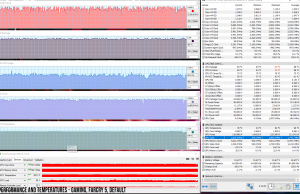


Overclocking the GPU without undervolting the CPU leads to even higher temperatures, which settle at around 90 degrees C for the CPU and 80 degrees for the GPU in the more demanding titles. That’s the price you have to pay for this kind of performance in still a fairly compact body.
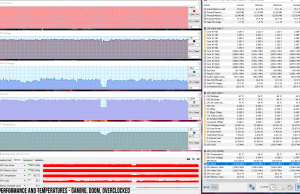



The last aspect we’ll mention in this section is the performance on battery, which is actually not bad. Both the CPU and the GPU are capped down and cannot match the frequencies they hit while the laptop is plugged in, but at 1.9 GHz for the CPU and 1.4 GHz for the GPU, you can still get good framerates in most titles.

Emissions (noise, heat), Connectivity and speakers
There’s a fairly complex cooling solution on this laptop, with two large 12v fans with Anti Dust technology and a mix of various heatpipes meant to cool the CPU, GPU, and VRM.
This does a good job at keeping the hardware at bay, but the CPU and GPU run at high temperatures, perhaps higher than I’d expect on a laptop that’s compact, but still a bit thicker than the most ultraportable options out there. The fans inside also ramp up to louder levels than the average pack, hitting up to 60 dB at head-level on the Overclocked profile.
I should also add that I couldn’t find any way to create a custom fan profile in the current Armoury Crate app that came preinstalled on this laptop, so I had to rely on the Auto fan settings associated with the Power profiles, which actually worked fine while running demanding loads. However, both fans remain active even on the Silent profile, so this laptop never gets completely quiet. At 37-38 dB at head-level though, you’ll only hear them in quiet environments. I should also add that I didn’t hear and perceivable electronic noises on our sample, but that’s not a guarantee you won’t get coil whine with your units.
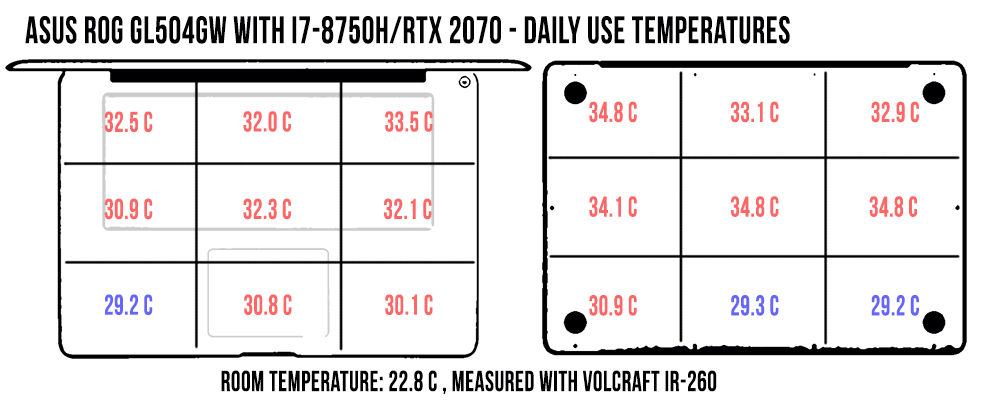
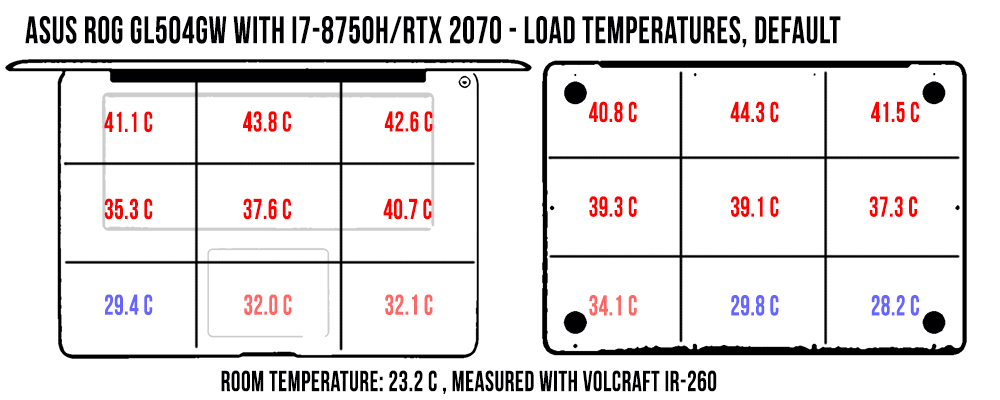
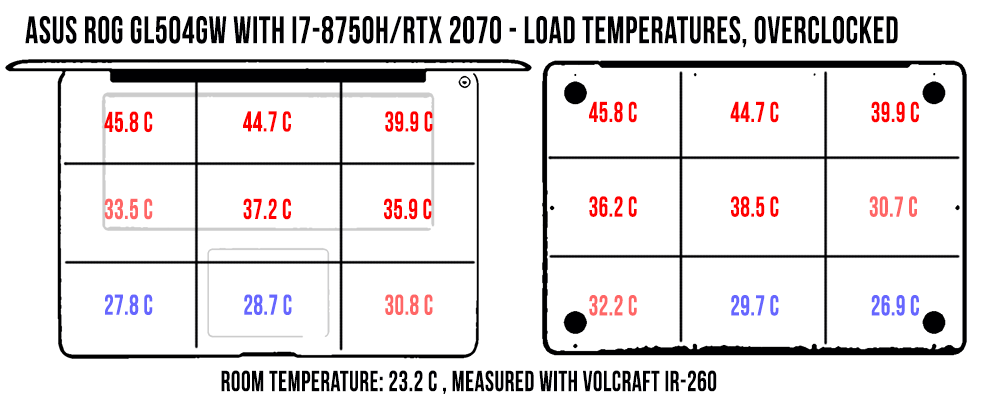
*Daily Use, Silent Profile (fans at ~37-38 dB) – Netflix clip in EDGE for 30 minutes
*Load Default, Turbo Profile (fans at ~57-58 dB) – playing FarCry 5 for approximately 30+ minutes on ultra FHD settings
*Load Overclocked, Turbo Profile, OC GPU (fans at ~60 dB) – playing FarCry 5 for approximately 30+ minutes on ultra FHD settings
For connectivity, there’s Wireless AC and Bluetooth on this laptop, through an Intel 9560 wi-fi module, but also Gigabit Lan through a Realtek RTL8168/8111 module. We’ve mostly used our unit on wireless and aside from the fact that it doesn’t reach the speeds of other implementations with our router, there’s nothing to complain about, as it offers stable signal strength and speeds both near the router and at 30+ feet, with walls in between.
The audio is ensured by a pair of punchy speakers that fire through narrow cuts on the laptop’s sides. They’re fairly loud, at up to 80-81 dB at head level, and they sound nice and rich, even at the lower end, with little to no distortions at higher volumes.
As for the webcam, it’s a standard HD cam and is placed beneath the screen, towards the right side, thus it’s a nose-cam with mediocre image quality. I doubt you’ll want to use this often, if at all.
Battery life
All ROG GL504s get an averagely sized 66 Wh battery, as well as Nvidia’s Optimus technology this time around. The high-refresh rate screen and powerful hardware do take their fair toll though, thus you’ll only get average battery life in most scenarios.
Here’s what we got in our test, with the screen set at 30% brightness, roughly 120 nits:
17 W (~3 h 50 min of use) – text editing in Google Drive, Silent Power Profile, screen at 30%, Wi-Fi ON;
13.5 W (~5 h of use) – 1080p Youtube fullscreen in Edge, Silent Power Profile, screen at 30%, Wi-Fi ON;
13.5 W (~5 h of use) – 1080p Netflix fullscreen video in Edge, Silent Power Profile, screen at 30%, Wi-Fi ON;
14 W (~4 h 40 min of use) – 4K fullscreen .mkv video in the Movie app, Silent Power Profile, screen at 30%, Wi-Fi ON;
24 W (~2 h 40 min of use) – browsing in Edge, Balancer Power Profile, screen at 30%, Wi-Fi ON;
42 W (~1 h 30 min of use) – Gaming – Middle Earth: Shadow of Mordor, Balanced Power Profile, screen at 30%, Wi-Fi ON.
We did run into a few issues on our sample. First of all, the preinstalled GameFirst app constantly loaded the CPU and affected battery life in most scenarios, so I ended up disabling it. In fact, I would suggest simply uninstalling it. Besides that, Edge also summoned the dGPU with the current set of drivers, so I had to manually adjust it to use the iGPU from the Nvidia Control Panel in order to get proper battery life with browsing, Youtube and Netflix.
Asus pairs this configuration with a 230 Wh power brick. It’s averagely sized and weighs around 1.76 lbs (.8 kg) for the European version, including cables. A full battery charge takes a little under 2 hours.
Price and availability
The ROG Strix GL504GW Scar II Edition is available in most regions of the world as of February 2019.
The most widely spread configuration includes the Core i7-8750H processor, 16 GB of RAM (1 stick), the RTX 2070 8GB graphics chip and a 512 GB NVMe SSD, as well as the 144HZ matte screen, for an MSRP in the US. As a side note, MicroCenter actually sells this refurbished at, so there’s a good chance you’ll find it discounted here and there.
In Europe, the base model comes with a 256 GB SSD and 1 TB SSHD, and starts at . Don’t forget that you’ll have to add one more RAM stick in order to get the best gaming results, as shown in the Performance section.
Final thoughts
The 2019 ROG Strix SCAR is merely a hardware bump of last year’s models, as mentioned from the beginning. However, last year’s models were some of our favorite mid-range gaming laptops of their generations and actually scored a 4.25 in our reviews, which is a high rating coming from us.
The GL504GW improves on performance by 20-25% over the GTX 1070 versions of 2018, once you overclock the GPU. It also adds Optimus, something the predecessor lacked, which helps with battery life when not running games. At the same time, the GL504GW is more expensive than the older versions, starting at , but that’s actually surprisingly competitive in today’s market for a full-power RTX 2070 15-incher, as rivals with similar builds and specs, like the MSI GE63 and GE65 Raider and the Aorus 15 X9, are even more expensive and get less storage.
So, are these enough to bump the ROG GL504GW to a 4.5 out of 5? We considered it, but decided against, as there are still some specific aspects where the GL504GW scores poorer than it should.
It doesn’t get a Thunderbolt 3 port, per-key illumination, a simple design or a good camera, but these I could probably let slide. My main nit is with how hot the internal components get with gaming, despite the fact that the fans run loud and the outer shell stays cool: 90 C for the CPU and 80+ C for the GPU are higher temperatures than on almost any other laptop we’ve reviewed in the past, that’s why I would probably recommend repasting the components. Repasting voids warranty though, which means you should probably get this laptop for a reseller that can do it for you.
Still, given the fact that our review test unit was a pre-release sample, I’d look into other in-depth reviews of final retail models to see how those handle thermals.
Update: In the meantime, Asus has released the ROG Scar III G531 which addresses the thermal issues of the Scar II,
My other complaint is with the fact that, as far as I can tell, the base configurations come with a single stick of RAM, and we’ve talked about how much dual-channel RAM matters in games. That means you’ll actually have to spend extra to add another stick of RAM.
With lower temperatures and dual-channel memory out fo the box, this would actually get a 4.5 . Either way, the ROG GL504GW is still one of the better compact 15-inch gaming laptops with RTX graphics, as it performs better than the RTX 2080 Max-Q options out there, but at a fraction of the cost. Thus if performance in games and demanding loads and value for your buck are what you’re primarily interested in, this is one of the best options out there.
That pretty much wraps up our review of the Asus ROG Strix GL504GW Scar II. We’re looking for your feedback and opinions down below in the comments section, and don’t hesitate to get in touch if you have any questions or need help deciding on your next gaming machine.
Learn more about the ASUS GL704GW-DS76
ModelBrandASUSSeriesROG Strix Scar IIModelGL704GW-DS76Part Number90NR00M1-M00550
Quick InfoColorROG Scar II Edition (Gunmetal + Camou-Weave)Operating SystemWindows 10 Home 64-bitCPUIntel Core i7-8750H 2.20 GHzScreen17.3" 144 HzMemory16 GB DDR4Storage512 GB PCIe NVMe SSD + 1 TB SSHD (8 GB Cache) FireCudaGraphics CardGeForce RTX 2070Video Memory8 GB GDDR6Dimensions (W x D x H)15.70" x 10.70" x 1.00"Weight6.40 lbs.
CPUCPU TypeIntel Core i7 8th GenCPU Speed8750H (2.20 GHz)Number of Cores6-core ProcessorCore NameCoffee LakeTurbo FrequencyUp to 3.90 GHzCPU L3 Cache9 MB
DisplayScreen Size17.3"TouchscreenNoWide Screen SupportYesDisplay TypeFull HDResolution1920 x 1080PanelIPSRefresh Rate144 HzLCD Features144 Hz 3 ms, IPS-Level, Matte
Operating SystemsOperating SystemWindows 10 Home 64-bit
GraphicsGPU/VPUNVIDIA GeForce RTX 2070Video Memory8 GBGraphic TypeDedicated Card
StorageSSD512 GBHDD1 TB SSHDStorage Spec512 GB PCIe NVMe SSD + 1 TB SSHD (8 GB Cache) FireCuda
MemoryMemory16 GBMemory Spec16 GB x 1Memory Slot (Total)2Memory Slot (Available)1
Optical DriveOptical Drive TypeNo
CommunicationsWLAN802.11ac Wireless LANBluetoothBluetooth 5.0
PortsUSB1 x USB 3.1 Gen 2 Type-A
1 x USB 3.1 Gen 2 Type-C
3 x USB 3.1 Gen 1 Type-AVideo Port1 x Mini DisplayPortHDMI1 x HDMIAudio Ports1 x Headphone/Microphone Combo Jack
Output DeviceVirtual Reality ReadyYes
Input DeviceKeyboardRGB (4-Zone) KeyboardBacklit KeyboardBacklitWebcamHD Web CameraCard ReaderSD
GeneralStyleThin and LightTypeGaming & EntertainmentUsageConsumer
PowerBattery66 WHrs, 4S1P, 4-cell Li-ion
FeaturesPackage ContentMarketing Giveaway (3D ROG Sculpture)
Dimensions & WeightDimensions (W x D x H)15.70" x 10.70" x 1.00"Weight6.40 lbs.
Additional InformationDate First AvailableFebruary 16, 2019
Asus ROG Strix Scar II Gaming Laptop, 17.3” 144Hz IPS-Type FHD, NVIDIA GeForce RTX 2070 8GB

amazon affiliate link below











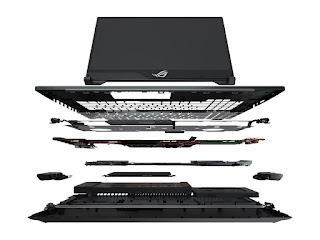







Post a Comment